6.3: Inside the Earth
- Page ID
- 2557
Before you can learn about plate tectonics, you need to know something about the layers that are found inside Earth. These layers are divided by composition into core, mantle, and crust or by mechanical properties into lithosphere and asthenosphere. Scientists use information from earthquakes and computer modeling to learn about Earth’s interior.
EXPLORING EARTH’S INTERIOR
How do scientists know what is inside the Earth? We don’t have direct evidence! Rocks yield some clues, but they only reveal information about the outer crust. In rare instances, a mineral, such as a diamond, comes to the surface from deeper down in the crust or the mantle. To learn about Earth’s interior, scientists use energy to “see” the different layers of the Earth, just like doctors can use an MRI, CT scan, or x-ray to see inside our bodies.
SEISMIC WAVES
One ingenious way scientists learn about Earth’s interior is by looking at how energy travels from the point of an earthquake. These are seismic waves (figure 1). Seismic waves travel outward in all directions from where the ground breaks at an earthquake. These waves are picked up by seismographs around the world. Two types of seismic waves are most useful for learning about Earth’s interior.
- P-waves (primary waves) are fastest, traveling at about 6 to 7 kilometers (about 4 miles) per second, so they arrive first at the seismometer. P-waves move in a compression/expansion type motion, squeezing and unsqueezing earth materials as they travel. This produces a change in volume for the material. P-waves bend slightly when they travel from one layer into another. Seismic waves move faster through denser or more rigid material. As P-waves encounter the liquid outer core, which is less rigid than the mantle, they slow down. This makes the P-waves arrive later and further away than would be expected. The result is a P-wave shadow zone. No P-waves are picked up at seismographs 104° to 140° from the earthquakes focus.
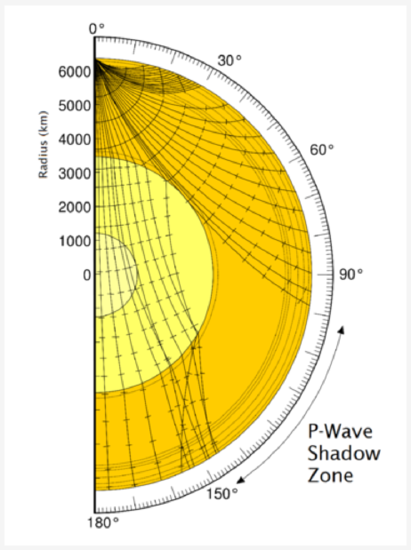
Figure 1. How P-waves travel through Earth’s interior. - S-waves (secondary waves) are about half as fast as P-waves, traveling at about 3.5 km (2 miles) per second, and arrive second at seismographs. S-waves move in an up and down motion perpendicular to the direction of wave travel. This produces a change in shape for the earth materials they move through. Only solids resist a change in shape, so S-waves are only able to propagate through solids. S-waves cannot travel through liquid.
By tracking seismic waves, scientists have learned what makes up the planet’s interior (figure 2).
- P-waves slow down at the mantle core boundary, so we know the outer core is less rigid than the mantle.
- S-waves disappear at the mantle core boundary, so the outer core is liquid.
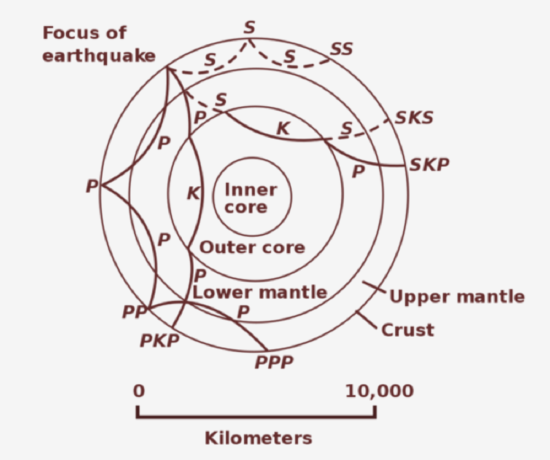
Figure 2. Letters describe the path of an individual P-wave or S-wave. Waves traveling through the core take on the letter K.
This animation shows a seismic wave shadow zone.
Other Clues About Earth's Interior
- Earth’s overall density is higher than the density of crustal rocks, so the core must be made of something dense, like metal.
- Since Earth has a magnetic field, there must be metal within the planet. Iron and nickel are both magnetic.
- Meteorites are the remains of the material that formed the early solar system and are thought to be similar to material in Earth’s interior (figure 3).
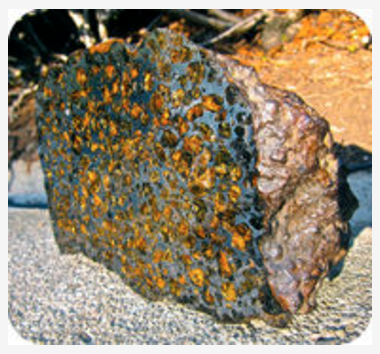
Figure 3. This meteorite contains silica minerals and iron-nickel. The material is like the boundary between Earth’s core and mantle.
THE EARTH’S LAYERS
The layers scientists recognize are pictured in figure 4.

Figure 4. A cross section of Earth showing the following layers: (1) crust (2) mantle (3a) outer core (3b) inner core (4) lithosphere (5) asthenosphere (6) outer core (7) inner core.
Core, mantle, and crust are divisions based on composition:
- The crust is less than 1% of Earth by mass. The oceanic crust is mafic, whilecontinental crust is often more felsic rock.
- The mantle is hot, ultramafic rock. It represents about 68% of Earth’s mass.
- The core is mostly iron metal. The core makes up about 31% of the Earth.
Lithosphere and asthenosphere are divisions based on mechanical properties:
- The lithosphere is composed of both the crust and the portion of the upper mantle that behaves as a brittle, rigid solid.
- The asthenosphere is partially molten upper mantle material that behaves plastically and can flow.
This animation shows the layers by composition and by mechanical properties.
Crust and Lithosphere
Earth’s outer surface is its crust; a cold, thin, brittle outer shell made of rock. The crust is very thin, relative to the radius of the planet. There are two very different types of crust, each with its own distinctive physical and chemical properties, which are summarized in table 1.
| Crust | Thickness | Density | Composition | Rock types |
|---|---|---|---|---|
| Oceanic | 5-12 km (3-8 mi) | 3.0 g/cm3 | Mafic | Basalt and gabbro |
| Continental | Avg. 35 km (22 mi) | 2.7 g/cm3 | Felsic | All types |
Oceanic crust is composed of mafic magma that erupts on the seafloor to create basalt lava flows or cools deeper down to create the intrusive igneous rock gabbro (figure 5).
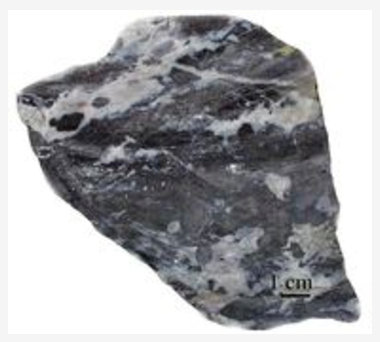
Figure 5. Gabbro
Sediments, primarily muds and the shells of tiny sea creatures, coat the seafloor. Sediment is thickest near the shore where it comes off the continents in rivers and on wind currents.
Continental crust is made up of many different types of igneous, metamorphic, and sedimentary rocks. The average composition is granite, which is much less dense than the mafic rocks of the oceanic crust (figure 6). Because it is thick and has relatively low density, continental crust rises higher on the mantle than oceanic crust, which sinks into the mantle to form basins. When filled with water, these basins form the planet’s oceans.
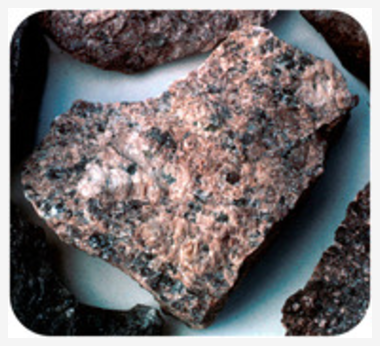
Figure 6. This granite from Missouri is more than 1 billion years old.
The lithosphere is the outermost mechanical layer, which behaves as a brittle, rigid solid. The lithosphere is about 100 kilometers thick. Look at figure 4. Can you find where the crust and the lithosphere are located? How are they different from each other?
The definition of the lithosphere is based on how earth materials behave, so it includes the crust and the uppermost mantle, which are both brittle. Since it is rigid and brittle, when stresses act on the lithosphere, it breaks. This is what we experience as an earthquake.
Mantle
The two most important things about the mantle are: (1) it is made of solid rock, and (2) it is hot. Scientists know that the mantle is made of rock based on evidence from seismic waves, heat flow, and meteorites.
The properties fit the ultramafic rock peridotite, which is made of the iron- and magnesium-rich silicate minerals (figure 7). Peridotite is rarely found at Earth’s surface.
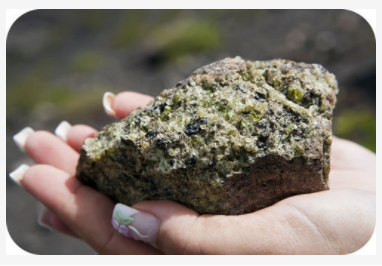
Figure 7. Peridotite is formed of crystals of olivine (green) and pyroxene (black).
Scientists know that the mantle is extremely hot because of the heat flowing outward from it and because of its physical properties.
Heat flows in two different ways within the Earth:
- Conduction: Heat is transferred through rapid collisions of atoms, which can only happen if the material is solid. Heat flows from warmer to cooler places until all are the same temperature. The mantle is hot mostly because of heat conducted from the core.
- Convection: If a material is able to move, even if it moves very slowly, convection currents can form.
Convection in the mantle is the same as convection in a pot of water on a stove. Convection currents within Earth’s mantle form as material near the core heats up. As the core heats the bottom layer of mantle material, particles move more rapidly, decreasing its density and causing it to rise. The rising material begins the convection current. When the warm material reaches the surface, it spreads horizontally. The material cools because it is no longer near the core. It eventually becomes cool and dense enough to sink back down into the mantle. At the bottom of the mantle, the material travels horizontally and is heated by the core. It reaches the location where warm mantle material rises, and the mantle convection cell is complete (figure 8).

Figure 8. Convections
Core
At the planet’s center lies a dense metallic core. Scientists know that the core is metal because:
- The density of Earth’s surface layers is much less than the overall density of the planet, as calculated from the planet’s rotation. If the surface layers are less dense than average, then the interior must be denser than average. Calculations indicate that the core is about 85% iron metal with nickel metal making up much of the remaining 15%.
- Metallic meteorites are thought to be representative of the core. The 85% iron/15% nickel calculation above is also seen in metallic meteorites (figure 9).
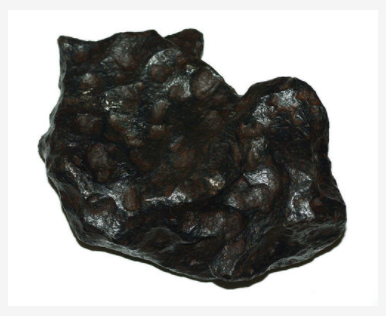
Figure 9. An iron meteorite is the closest thing to the Earth’s core that we can hold in our hands.
If Earth’s core were not metal, the planet would not have a magnetic field. Metals such as iron are magnetic, but rock, which makes up the mantle and crust, is not.
Scientists know that the outer core is liquid and the inner core is solid because:
- S-waves stop at the inner core.
- The strong magnetic field is caused by convection in the liquid outer core. Convection currents in the outer core are due to heat from the even hotter inner core.
The heat that keeps the outer core from solidifying is produced by the breakdown of radioactive elements in the inner core.
LESSON SUMMARY
- Earth is made of three layers: the crust, mantle, and core.
- The brittle crust and uppermost mantle are together called the lithosphere.
- Beneath the lithosphere, the mantle is solid rock that can flow, or behave plastically.
- The hot core warms the base of the mantle, which causes mantle convection.
REFLECTION QUESTIONS
- What skill does this content help you develop?
- What are the key topics covered in this content?
- How can the content in this section help you demonstrate mastery of a specific skill?
- What questions do you have about this content?
Contributors and Attributions
Original content from Kimberly Schulte (Columbia Basin College) and supplemented by Lumen Learning. The content on this page is copyrighted under a Creative Commons Attribution 4.0 International license.

